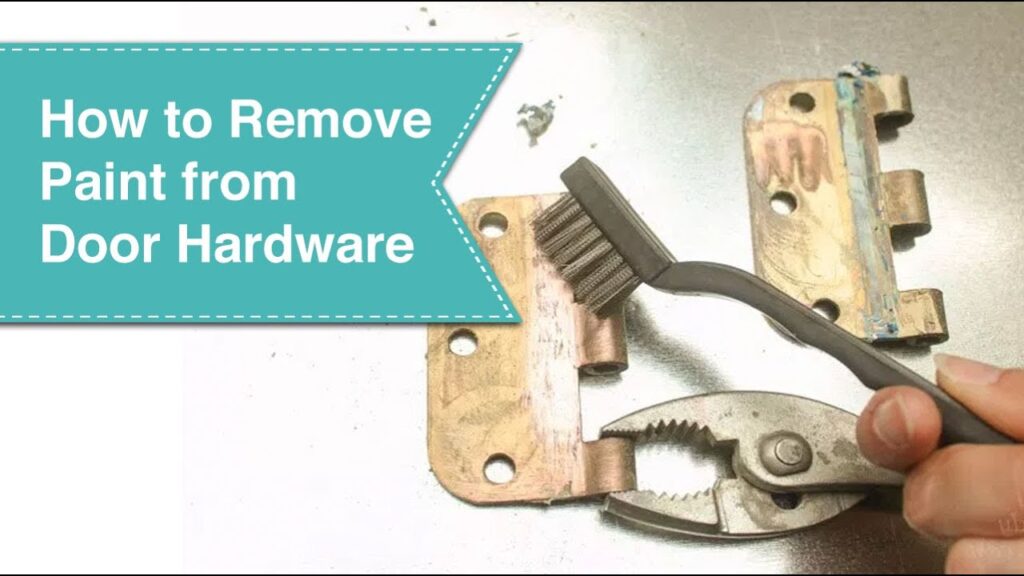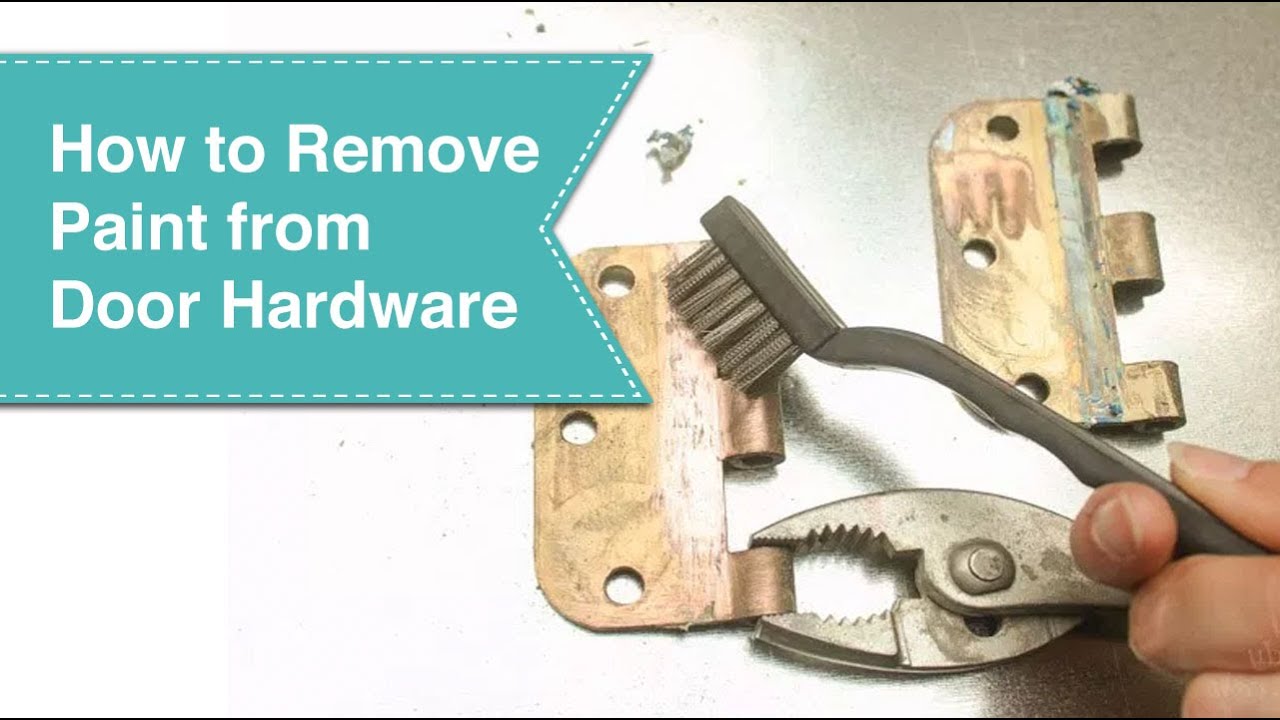
How to Remove Paint from Brass Hinges Without Removing Them: A Step-by-Step Guide
Dealing with paint-covered brass hinges can be a frustrating endeavor, especially when you want to restore their original luster without the hassle of removing them. Whether you’re renovating an old home or simply giving your doors a fresh look, knowing how to remove paint from brass hinges without removing them is a valuable skill. This comprehensive guide will walk you through various methods, providing you with the knowledge and techniques to achieve professional-looking results while minimizing the risk of damage.
Brass hinges are often chosen for their durability and aesthetic appeal, but layers of paint can obscure their beauty and hinder their function. Removing the paint carefully is essential to preserve the integrity of the brass. This article will explore several effective methods, including chemical strippers, heat guns, and manual techniques, ensuring you can choose the approach that best suits your needs and the condition of your hinges. Each method comes with its own set of precautions and best practices, which we will cover in detail to help you avoid common pitfalls.
Understanding Brass and Paint Removal
Before diving into the methods, it’s crucial to understand the properties of brass and the types of paint you might encounter. Brass is an alloy of copper and zinc, known for its corrosion resistance and attractive golden color. However, it’s also relatively soft and can be easily scratched or damaged by harsh chemicals or abrasive tools. Therefore, a gentle and controlled approach is always recommended when removing paint from brass hinges.
The type of paint on your hinges will also influence your choice of removal method. Latex paint, commonly used for interior walls, is generally easier to remove than oil-based or enamel paints, which are more durable and resistant to solvents. Identifying the type of paint will help you select the most effective and least damaging removal technique. Consider testing a small, inconspicuous area first to assess how the paint reacts to your chosen method.
Method 1: Using Chemical Paint Strippers
Chemical paint strippers are a popular option for removing paint from brass hinges, especially when dealing with multiple layers of paint or stubborn coatings. These products work by softening the paint, making it easier to scrape away. However, it’s essential to choose a stripper that is safe for use on brass and to follow the manufacturer’s instructions carefully to avoid damaging the metal or creating hazardous fumes.
Choosing the Right Chemical Stripper
When selecting a chemical stripper, look for one that is specifically formulated for use on metal surfaces. Avoid products containing harsh chemicals like methylene chloride, which can damage brass and pose serious health risks. Instead, opt for a milder, solvent-based stripper or a bio-based alternative. Always read the product label and safety data sheet (SDS) before use.
Applying the Chemical Stripper
- Prepare the area: Cover the surrounding surfaces with drop cloths or plastic sheeting to protect them from spills and splatters. Ensure adequate ventilation by opening windows or using a fan.
- Apply the stripper: Using a brush, apply a thick, even layer of the chemical stripper to the painted surfaces of the brass hinges. Avoid applying the stripper to any unpainted areas, as it may discolor or damage the brass.
- Allow dwell time: Let the stripper sit for the recommended dwell time, as specified by the manufacturer. This allows the chemicals to penetrate and soften the paint layers.
- Remove the softened paint: Use a plastic scraper or putty knife to gently remove the softened paint. Avoid using metal tools, as they can scratch the brass. Work in the direction of the grain to minimize the risk of damage.
- Clean the hinges: Once all the paint has been removed, clean the hinges with a mild detergent and water to remove any residue from the chemical stripper. Rinse thoroughly and dry with a soft cloth.
Safety Precautions
- Always wear appropriate personal protective equipment (PPE), including gloves, eye protection, and a respirator, when working with chemical strippers.
- Work in a well-ventilated area to avoid inhaling harmful fumes.
- Dispose of used stripper and paint residue properly, according to local regulations.
- Keep chemical strippers out of reach of children and pets.
Method 2: Using a Heat Gun
A heat gun can be an effective tool for removing paint from brass hinges, as it softens the paint, making it easier to scrape away. However, it’s crucial to use caution and avoid overheating the brass, which can cause it to warp or discolor. A heat gun offers a dry method for removing paint, reducing mess compared to chemical strippers. It also gives you more control over the paint removal process.
Applying Heat Safely
- Prepare the area: As with chemical strippers, protect surrounding surfaces with drop cloths or plastic sheeting. Ensure good ventilation.
- Apply heat: Hold the heat gun several inches away from the painted surface and move it in a slow, sweeping motion. Avoid holding the heat gun in one spot for too long, as this can overheat the brass.
- Scrape the softened paint: As the paint softens, use a plastic scraper or putty knife to gently remove it. Work in the direction of the grain and avoid applying too much pressure.
- Cool the hinges: Allow the hinges to cool completely before handling them.
Safety Precautions
- Always wear heat-resistant gloves and eye protection when working with a heat gun.
- Work in a well-ventilated area to avoid inhaling fumes from the heated paint.
- Be careful not to overheat the brass, as this can damage it.
- Keep the heat gun away from flammable materials.
Method 3: Manual Scraping and Sanding
For smaller areas or delicate hinges, manual scraping and sanding can be a gentle and effective method for removing paint from brass hinges. This approach allows for precise control and minimizes the risk of damage. While it may be more time-consuming, it’s often the safest option for valuable or antique hinges.
Scraping and Sanding Techniques
- Prepare the area: Clean the hinges with a mild detergent and water to remove any dirt or grime.
- Scrape the paint: Use a plastic scraper or putty knife to gently remove loose or flaking paint. Work in the direction of the grain and avoid applying too much pressure.
- Sand the remaining paint: Use fine-grit sandpaper (220-grit or higher) to gently sand away any remaining paint. Wrap the sandpaper around a sanding block to distribute the pressure evenly and avoid scratching the brass.
- Polish the hinges: Once all the paint has been removed, polish the hinges with a brass polish to restore their shine.
Tips for Success
- Use a light touch when scraping and sanding to avoid damaging the brass.
- Work in the direction of the grain to minimize the risk of scratches.
- Use a variety of sanding grits, starting with a coarser grit to remove the bulk of the paint and finishing with a finer grit to smooth the surface.
- Regularly clean the sandpaper to prevent it from becoming clogged with paint.
Preventing Future Paint Buildup
Once you’ve successfully removed paint from brass hinges, taking steps to prevent future paint buildup can save you time and effort in the long run. Here are a few tips:
- Mask the hinges: When painting doors or trim, mask the hinges with painter’s tape to protect them from overspray.
- Remove the hinges: If possible, remove the hinges before painting and reattach them after the paint has dried.
- Apply a protective coating: Apply a clear coat of lacquer or varnish to the hinges to protect them from paint and other contaminants.
- Regular cleaning: Routinely clean the hinges with a soft cloth and mild detergent to remove any dirt or grime that could attract paint.
Conclusion
Removing paint from brass hinges without removing them can be a rewarding project that restores the beauty and functionality of your doors. By following the methods and precautions outlined in this guide, you can achieve professional-looking results while minimizing the risk of damage. Whether you choose to use chemical strippers, a heat gun, or manual techniques, remember to work carefully and take your time. With a little patience and attention to detail, you can transform your paint-covered hinges into gleaming accents that enhance the overall aesthetic of your home.
Consider also the environmental impact of your chosen paint removal method. Environmentally friendly paint strippers are available, and proper disposal of waste materials is crucial. Always consult local regulations for hazardous waste disposal. By prioritizing safety and environmental responsibility, you can ensure a successful and sustainable paint removal project.
[See also: Restoring Antique Brass Hardware]
[See also: Best Brass Polishing Techniques]
[See also: How to Clean Brass Without Damaging It]

